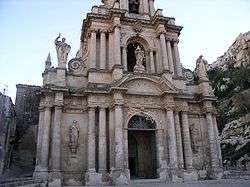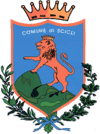Scicli
| Scicli | ||
|---|---|---|
| Comune | ||
| Comune di Scicli | ||
|
The church of St. Bartholomew. | ||
| ||
 Scicli Location of Scicli in Italy | ||
| Coordinates: 36°47′N 14°42′E / 36.783°N 14.700°E | ||
| Country | Italy | |
| Region | Sicily | |
| Province / Metropolitan city | Ragusa (RG) | |
| Frazioni | Donnalucata, Sampieri, Cava d'Aliga and Playa Grande | |
| Government | ||
| • Mayor | Franco Susino | |
| Area | ||
| • Total | 137.57 km2 (53.12 sq mi) | |
| Elevation | 108 m (354 ft) | |
| Population (31 January 2009[1]) | ||
| • Total | 26,215 | |
| • Density | 190/km2 (490/sq mi) | |
| Demonym(s) | Sciclitani | |
| Time zone | CET (UTC+1) | |
| • Summer (DST) | CEST (UTC+2) | |
| Postal code | 97018 | |
| Dialing code | 0932 | |
| Saint day | Last Saturday of May | |
| Website | Official website | |
Scicli is a city in the Province of Ragusa in the south east of Sicily, Italy. It is 25 kilometres (16 mi) from Ragusa, and 308 kilometres (191 mi) from Palermo. Alongside seven other cities in the Val di Noto, it has been listed as one of UNESCO's World Heritage Sites.
History
Settlements of the area of Scicli dates back to the Copper and Early Bronze Ages (3rd millennium BCE to the 15th century BCE).
Scicli was founded by the Sicels (whence probably the name) around 300 BCE.
In 864 CE, Scicli was conquered by the Arabs, as part of the Muslim conquest of Sicily.[2] Under their rule it flourished as an agricultural and trade center. According to geographer Muhammad al-Idrisi, "shipping reached Scicli in Sicily from Calabria, Africa, Malta and many other places."[3]
In 1091, it was conquered from the Arabs by the Normans, under Roger I of Hauteville, after a fierce battle.[4] Scicli was one of the garrison which rebelled against the Angevine domination in the Sicilian Vespers (April 5, 1282). Following the various dynasties ruling the Kingdom of Sicily, it was an Aragonese-Spanish possession before being united in the Kingdom of Italy in the mid 19th century.
Following a catastrophic earthquake in 1693, much of the town was rebuilt in the Sicilian baroque style, which today gives the town the elegant appearance which draws many tourists to visit it.
Main sights
- San Matteo: this church was the local Mother Church until 1874. It is located on the eponymous hill in the Old City, where there is also the ruin of an Arab/Norman castle.[5]
- The church of Santa Marìa la Nova, with a huge Neoclassicist façade. The interior houses a cypresse-wood statue of Madonna della Pietà, probably of Byzantine origin.
- San Bartolomeo baroque church
- Sant'Ignazio (Mother Church of St. Ignatz), housing the highly venerated image of Madonna dei Milìci (see Culture section).
- San Michele Arcangelo
- Santa Maria la Nova
- Palazzo Fava, one of the first and largest Baroque palaces in the town. Notable are the late-Baroque decorations of the portal and the balconies, especially the one on the Via San Bartolomeo.
- The Town Hall, the Palazzo Spadaro and the Palazzo Beneventano, all boasting Baroque decorations.
Culture
The city is also frequently used as a film set, most recently for Marco Bellocchio's Il regista dei matrimoni and is popular in Italy as the home of Il Commissario Montalbano, the popular television series broadcast by RAI.
The city is also notable for its religious processions which includes "Presepe" (nativity scenes) enacted in the caves surrounding the city at Christmas time. These caves, known as the Chiarafura caves, were dug out in the tuff cliffs, and some were inhabited by the local poor as recently as 1958.
At Easter, the city celebrates with the "Uomo Vivo" parade which involves a long religious procession through the city. A decorated horse parade takes place in March, from Scicli to the neighbouring town of Donnalucata. The most spectacular religious festival, the A Maronna i Milici occurs in May, commemorating the appearance of the Madonna on a white horse holding aloft a sword, described as "probably...the only armed Holy Virgin in the world."[6] This encouraged the Christian Normans to defeat the Saracens in 1091. However, the story itself is believed to have been first promoted no earlier than the 15th century.[7]
The economy of the city is mostly agricultural, and the area is renowned for its many greenhouses producing the primizie ("early fruits") that are exported all over Italy.
The city plays host to an annual road running race, Memorial Peppe Greco, which traces its route through the city centre.
| Late Baroque Towns of the Val di Noto (South-Eastern Sicily) | |
|---|---|
| Name as inscribed on the World Heritage List | |
| Type | Cultural |
| Criteria | i, ii, iv, v |
| Reference | 398 |
| UNESCO region | Europe and North America |
| Inscription history | |
| Inscription | 2002 (20th Session) |
References
- ↑ Data from ISTAT
- ↑ Alexander Mikaberidze (22 Jul 2011). Conflict and Conquest in the Islamic World: A Historical Encyclopedia [2 volumes]. ABC-CLIO. p. 831. ISBN 9781598843378.
- ↑ Lorenza De Maria; Rita Turchetti (2004). Rotte e porti del Mediterraneo dopo la caduta dell'Impero romano d'Occidente: continuità e innovazioni tecnologiche e funzionali : IV seminario : Genova, 18-19 giugno 2004. Rubbettino Editore. p. 125. ISBN 9788849811179.
- ↑ Authentic Sicily (illustrated ed.). Touring Editore. 2005. p. 73. ISBN 9788836534036.
- ↑ Peter Amann (1 Jan 2001). Sicily (illustrated ed.). Hunter Publishing, Inc. p. 42. ISBN 9781856911580.
- ↑ Marcella Croce (20 Oct 2014). The Chivalric Folk Tradition in Sicily: A History of Storytelling, Puppetry, Painted Carts and Other Arts. McFarland. p. 48. ISBN 9780786494156.
- ↑ Amy G. Remensnyder (2014). La Conquistadora: The Virgin Mary at War and Peace in the Old and New Worlds (illustrated ed.). Oxford University Press. p. 395. ISBN 9780199893003.
External links
| Wikimedia Commons has media related to Scicli. |
| Wikivoyage has a travel guide for Scicli. |
- (English) Scili Information
- Cartoon map of Scicli


